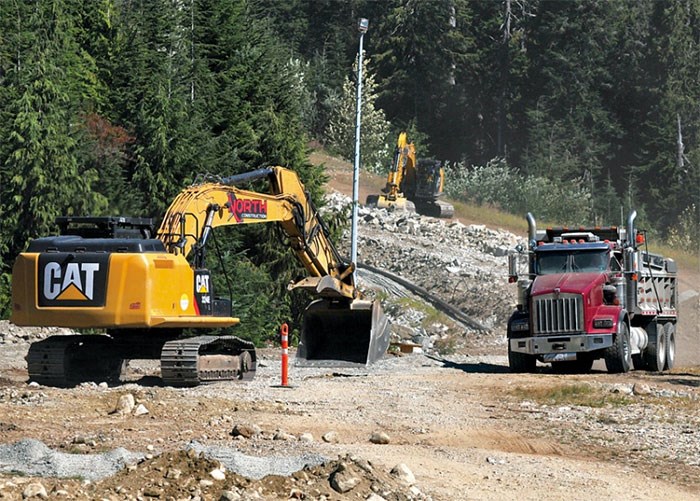 Work is underway on a $1.2 million snowmaking expansion at Cypress Mountain that includes the installation of five snow guns along Collins ski run to the top of the Lions Express chairlift, to be completed in time for this winter season. photo Paul McGrath, North Shore News
Work is underway on a $1.2 million snowmaking expansion at Cypress Mountain that includes the installation of five snow guns along Collins ski run to the top of the Lions Express chairlift, to be completed in time for this winter season. photo Paul McGrath, North Shore News
Hold on there, autumn.
While the equinox marking the first day of fall happens this Friday, Sept. 22, meteorologists predict balmy temperatures more reminiscent of summer could stick around for at least the next few weeks.
Further into the fall and winter, it’s anyone’s guess right now what the weather will hold, with the cooler influence of a La Nina weather pattern duking it out with warmer-than-usual Pacific Ocean temperatures.
In the more immediate term, temperatures across the Lower Mainland and much of B.C. are expected to remain at or above normal into October, said Erin Wenckstern, a meteorologist with The Weather Network.
That’s due to another building ridge of high pressure, she said.
A similar, although stronger high-pressure ridge made for a warm dry summer across western Canada this summer lasting into the start of September, say meteorologists.
Temperatures were “way above average through the first weeks of September,” said Doug Lundquist, a meteorologist with Environment Canada.
But fall is a changeable season.
“The average temperatures drop off by a degree a week, in some places by about three degrees a week,” said Wenckstern, until normal highs are back into the single digits. “It’s all relative.”
So far the winter outlook further ahead is anything but clear.
Local ski hills have been cheering the news that a La Nina weather pattern – which usually brings colder temperatures to the Lower Mainland – is predicted for this winter.
“That’s the best news ski resorts get,” said Joffrey Koeman, spokesman for Cypress Mountain resort in West Vancouver.
Last year’s La Nina certainly bore that out. “It was a cold season,” said Koeman. “There was a lot of snow. When the snow did fall it stayed.”
Ahead of this year’s ski season, Cypress is installing $1.2 million worth of snowmaking equipment, which will add snow guns and hydrants on runs up to the top of the Lions Express main chairlift on Mount Strachan. Previous snowmaking additions had mainly focused on Black Mountain, said Koeman.
With snow guns in place, as long as Mother Nature co-operates with cold temperatures at higher elevations, “we’ll be able to open up both sides of the mountain earlier,” said Koeman.
Snowmaking equipment is still dependent on temperatures staying at or below the freezing mark.
But the colder forces of La Nina could be tempered by the competing influence of warm ocean currents. “Right now waters off the coast of B.C. in the Pacific are really warm,” said Lundquist. “It’s more likely going to be the overshadowing factor.”
Because of that, long-range climate models are “all over the place,” said Lundquist.
Adding to the confusion are the recent series of typhoons and hurricanes that have hit the southern states and Caribbean countries. Some of those are so massive, they can change global weather patterns even a huge distance away, said Lundquist.
Read more from the North Shore News


